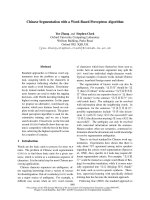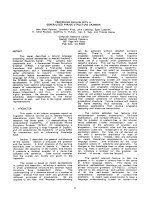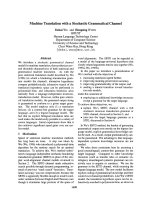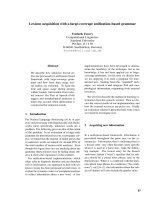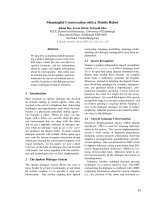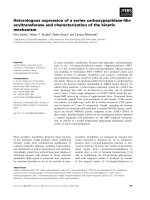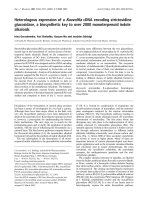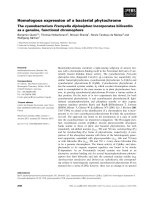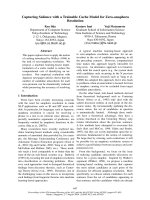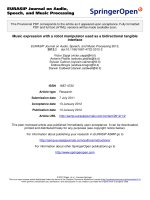Báo cáo toán học: " Music expression with a robot manipulator used as a bidirectional tangible interface" pptx
Bạn đang xem bản rút gọn của tài liệu. Xem và tải ngay bản đầy đủ của tài liệu tại đây (1.89 MB, 34 trang )
This Provisional PDF corresponds to the article as it appeared upon acceptance. Fully formatted
PDF and full text (HTML) versions will be made available soon.
Music expression with a robot manipulator used as a bidirectional tangible
interface
EURASIP Journal on Audio, Speech, and Music Processing 2012,
2012:2 doi:10.1186/1687-4722-2012-2
Victor Zappi ()
Antonio Pistillo ()
Sylvain Calinon ()
Andrea Brogni ()
Darwin Caldwell ()
ISSN 1687-4722
Article type Research
Submission date 7 July 2011
Acceptance date 13 January 2012
Publication date 13 January 2012
Article URL />This peer-reviewed article was published immediately upon acceptance. It can be downloaded,
printed and distributed freely for any purposes (see copyright notice below).
For information about publishing your research in EURASIP ASMP go to
/>For information about other SpringerOpen publications go to
EURASIP Journal on Audio,
Speech, and Music Processing
© 2012 Zappi et al. ; licensee Springer.
This is an open access article distributed under the terms of the Creative Commons Attribution License ( />which permits unrestricted use, distribution, and reproduction in any medium, provided the original work is properly cited.
Email addresses:
Music expression with a robot manipulator used as a
bidirectional tangible interface
Victor Zappi
∗
, Antonio Pistillo, Sylvain Calinon,
Andrea Brogni and Darwin Caldwell
Department of Advanced Robotics, Istituto Italiano di Tecnologia,
via Morego 30, Genova 16163, Italy
∗
Corresponding author:
AP:
SC:
AB:
DC:
Abstract
The availability of haptic interfaces in music content processing offers interesting
possibilities of performer-instrument interaction for musical expression. These new
musical instruments can precisely modulate the haptic feedback, and map it to a
sonic output, thus offering new artistic content creation possibilities. With this
article, we investigate the use of a robotic arm as a bidirectional tangible inter-
face for musical expression, actively modifying the compliant control strategy to
create a bind between gestural input and music output. The user can define recur-
2
sive modulations of music parameters by grasping and gradually refining periodic
movements on a gravity-compensated rob ot manipulator. The robot learns on-line
the new desired trajectory, increasing its stiffness as the modulation refinement
proceeds. This article reports early results of an artistic performance that has been
carried out with the collaboration of a musician, who played with the robot as part
of his live stage setup.
Keywords: robot music interface; physical human–robot interaction; haptic feed-
back; human–robot collaboration; learning by imitation.
1 Introduction
Composition and p erformance of music is evolving radically as technology offers
new paths and new means for artistic expression. When in the mid 70’s, the earliest
programmable music sequencers and drum machines were intro duced, for the first
time musicians had the opportunity to operate on devices able to play long music
sequences on their own, without the need of continuous human interaction. Since
then, the presence of controllable semi-autonomous machines in studios and on
stage has been stimulating the imagination of many artists. Bands like Kraftwerk
have been playing their music exclusively using these devices in conjunction with
analog and digital synthesizers, fostering with their production a future where
technology and robots could play an even more active role in musical expression [1].
Forty years have passed, and while Kraftwerk featured for the first time dancing
robots on their stage, music content processing by and for robots became a feasible
research topic and a realistic persp ective.
3
Nowadays humanoid robots are able to accomplish complex tasks like playing
musical instruments, improvising, and interacting with human and robot musical
partners [2]. This kind of robot emulates human behavior and human functioning,
thanks to fine mechatronic design and multimodal sensory systems. Other kinds
of robots, which we could call “ad hoc mechatronic devices”, completely lost their
anthropomorphic appearances, evolving towards shapes and models specifically
created to optimize the execution of arbitrary scores on musical instruments. For
example, these devices can be multi-armed automatic percussionists or motorized
string exciters [3,4].
Applications proposed so far with humanoid robots and ad hoc mechatronic
devices operate directly on the musical instrument, making use of data coming
from the remote human operator (on-line and off-line) and from the instrument
itself. Typically, physical interaction with a user is not allowed, since the robot
behaves as a completely autonomous musician rather than a musical interface.
The consideration of robots as both manipulators and actuated interfaces offers
new perspective in human–robot interaction, human-centered robotics, and music
content processing. Such actuated interfaces can take various roles and will re-
quire expertise from various fields of research such as robot control, haptics, and
interaction design.
This article aims to exploit these new hardware capabilities. Instead of consid-
ering separated interfaces to communicate and send commands to the robot, the
proposal is to explore the use of the robot as a tangible interface. We adopt the
persp ective that the most intuitive communication medium for a human–rob ot
interface is to transmit information directly through physical contact.
4
We take the perspective that, in the context of music playing, the musical
instrument or interface should not restrict the artist but instead provide him/her
with an intuitive and adaptive medium that can be used in the desired way. By
using the motor capabilities of the robot, the interface can create a new active role,
which moves the original perspective of the passive interface towards a human–
robot collaborative tool for musical expression.
The object of this study is to explore the use of a robotic arm as a bidirectional
compliant interface to control and create music. The user is allowed to define
low frequency oscillators gradually refining periodic movements executed on the
robot. Through this process, the user can grasp the rob otic arm and locally modify
the executed movement, which is learnt on-line, modulating the current musical
parameters. After releasing the arm, the robot continues the execution of the
movement in consecutive loops. During the interaction, the impedance parameters
of our robot controller are modified to produce a haptic feedback which guides the
user during the modulation task. We think that this feature may enhance the
modalities of artistic content creation, offering an unexplored approach to a very
common task in music composition and performance.
We collaborated with an electronic musician to observe the real flexibility and
the capabilities of such a system, when handled by a user with deep musical skills
but no robot interaction experience. To study in a practical scenario, we arranged
a performance making the robot part of a live stage setup, completely connected
with professional musical instruments and interfaces. The artist then created a
brand new musical composition, specifically conceived to exploit the expressive
possibilities of the system, and performed it live.
5
2 Compliant robot as tangible interface for music expression
Most of the commercially available robots are controlled by stiff actuators that
precisely reproduce a very accurate predefined movement in a constrained envi-
ronment, but these robots cannot be used close to people for safety reasons [5].
With the vibrant and promising advances in robot control, inverse dynamics, ac-
tive compliance and physical human–robot interaction, the robot’s articulations
progressively become tangible interfaces that can be directly manipulated by the
user while the robot is actuated [6–10].
Active compliance control allows the simulation of the physical properties of the
robot in a controlled manner. For example, it is possible to send motor commands
to compensate for the gravity and friction in the robot’s joints in order to provide
a backdrivable interface. In this way, the robot can be manipulated by the user
without effort since from the user’s perspective the robot appears to be “floating”
in space. The robot is controlled based on our previous study towards the use
of virtual dynamical systems in task space [9]. For example, the robot can move
towards a virtual attractor in 3D Cartesian space as if its dynamics was equivalent
to a virtual mass concentrated in its end-effector and attached by a virtual spring
and damper.
We propose to explore these control schemes in the context of music expres-
sion. The sophisticated sensing and manipulation skills humans have developed
should be taken into account when designing novel interfaces [11,12], in particular
tangible user interfaces can fulfill many of the special needs brought by the new
live computer music paradigms [13]. In general, haptic information is crucial to
play most musical instruments. For expert musicians, haptic information is even
6
more important than vision. For example, expert pianists or guitarists do not need
visual feedback of the hands to control the movement. This occurs because, in the
expert phase, tactile and kinesthetic feedback are important to allow a high level
of precision for certain musical functions [14]. In learning and music composition,
the standard gestural relationship is bidirectional: it includes transmission of our
gestures to the instrument, but also reception, perception of feedbacks, which are
fundamental to achieve control finesse [15].
We explore in this article how robot interfaces could recreate similar human-
instrument dynamics with varying haptic properties employed by the user as an
interface for musical expression. Compared to a standard musical instrument or
passive musical interface, the robot introduces three additional features. The first
one is the capability to continuously change the behaviors of the virtual dynamical
systems, with stiffness and damping parameters varying during the interaction.
This feature has been exploited in a vast number of previous studies and it is one of
the basic concepts in haptic interaction and haptic music research. The second one
consists of the capability to spatially redefine the types of movement and gesture
required to interact with the virtual instrument. This is done actively, through real-
time software control, which makes the robot different from a standard interface
that has these capabilities embedded in its hardware structure. Although some
interfaces that support software-based compliant control are available, the high
dimensionality of the robot control parameterization makes it a unique platform,
which could strongly support the study of unconventional and inspiring musical
interactions. The last feature is the capability to use the interface for both haptic
input and visual output processes. In other words, the instrument can be used to
continue or replay the music without using an external interface or visualization
7
tool. This is a powerful feature, which remains largely unexplored as a hardware
music interface.
Furthermore, such actuated interfaces offer new interaction capabilities where
the robot becomes part of the choreography. The interface can replay a recorded
sequence, which is interesting not only from an auditory perspective but also
from a visual perspective by synchronizing the audio output with a movement.
For example, the physical presence of the robot can complement the performer’s
presence on stage by temporarily adopting the role of a virtual music band player.
3 Related work
The use of haptics has often been exploited in music. Simulating the dynamics
which characterize non-digital traditional instruments, haptic interfaces are used
to make sound from a gesture interaction with an energetic coupling between the
instrument and the player [16]. Both the study of Cadoz et al. [15] and Gillespie et
al. [17] investigate the possibility to build a keyboard controller able to reproduce
the force feedback of a piano and other key-based instruments. The motors driving
the keys behavior feed back to the user force information typically perceived while
playing an instrument, like inertia, damping, and compliance. Other important
works address force feedback drifting away from traditional controllers, introducing
brand new devices in terms of shape and functionalities. Some examples are the
Plank [18], a one-axis force feedback controller used to explore methods of feeling
and directly manipulating sound waves and spectra, and Michel Waisvisz’s Web
[19], which affects sound texture and timbre changing the mechanical tension on
the various segments that compose its reticular structure. In the study presented
8
in [20] direct force feedback is replaced by vibrations. The system is meant to
facilitate the composition and perception of intricate, musically structured spatio-
temporal patterns of vibration on the surface of the body. This wide exploration
of haptics applied in the music domain has also deeply influenced the way human-
instrument interaction is taught, including haptic feedback in the list of the most
interesting features which characterize the design of novel interfaces [21].
Haptic capabilities of reactive robots are currently exploited to transfer to
and from humans important information linked to the learning of a task. Solis et
al. present in [22] the use of a reactive robot system in which a haptic interface
is employed to transfer skills from robots to unskilled persons. Different levels
of interaction were implemented with Japanese handwriting tasks. While the first
kind of interaction was mainly passive since it was using some pre-defined rules, the
second type, an active interaction modality, showed the capability of the robot to
dynamically adapt its behavior to user actions respecting their intentions without
significantly affecting their performance. Numerous researchers have dealt with
the problem of robot learning of motion and force patterns. In particular the
field of Robot programming by demonstration, also called learning by imitation or
learning from demonstration, explores the transfer of skills from human to robots
with generalization capabilities [23]. Instead of replicating the exact same task,
this line studies how the robot can extract the important features of the task and
reproduces those in new situations that have not been demonstrated. In [10], Lee
et al. present a physical human–robot interaction scenario in which human users
transfer to robots, by mean of demonstrations, several motor tasks, which can be
learnt on-line. By physically guiding the robot, the user can initially demonstrate
a movement which then is learnt and reproduced. During the execution of such
9
movements, the user can refine/modify the skill by grasping and moving the robot
and showing new trajectories that are learnt on-line. The robot controller adapts
the behavior of the manipulator to the forces applied by the user. Schaal et al. [24]
used dynamic movement primitives [25] to reproduce movements with adaptation
to final goal changes arising either before the beginning of the movement or during
it. We proposed in [26] the use of Gaussian mixture regression to learn the task
constraints not only in the form of a desired trajectory, but as a probabilistic
flow tube encapsulating variability and correlating information changing during
the task. In [27], we extended the approach to tasks in which both motion and
forces are required to perform a collaborative manipulation activity such as lifting
an object, and where the robot shows, after learning, the capability to adapt to
human motions and learn both the dynamic and communicative features of the
task. We started to explore in [28] the use of robot manipulators as both an input
and output device during physical human–robot interaction.
Another category of relevant studies investigated the possibility to create ro-
bots able to perceive and join a collaborative human activity such as playing music
with an ensemble. Petersen et al. [2] presented a flutist robot employed in a music
based interaction system using sensory information to generate a musical output
from the robot during an interaction established with human partners. Two levels
of interaction are implemented, beginners and advanced, which involve the use
of different sensors and schemes for elaborating the relative information to influ-
ence the robot behavior. The study presented in [29] describes a system in which
a robot theremin player interacts with a human drummer introducing the pos-
sibility of a novel synchronizing method for the human–robot ensemble through
coupled oscillators. Such oscillators are used by the robot to predict the user’s
10
playing speed and adapt to it. The experiments showed the effectiveness in re-
ducing the differences between humans’ and robot’s onset timing and in obtaining
better synchronized performances.
Particular interest is drawn onto the creation of robots which can take part
in live performances, as a means to create music or dance choreographies. For ex-
ample, specific classes are available at the California Institute of the Art, during
which the history and art of musical robotics are taught [3]. In 2009, the Mu-
sic Technology program and the Technical Direction program built four new ad
hoc mechatronic devices, designed to perform with ten human performers in the
Machine Orchestra. The study presented in [30] describes the use of four mobile
robotic platforms/interfaces to create multimodal artistic environments for music
and dance performance. These robotic interfaces are employed as instruments with
the capability to move in a given space and display reactive motions on a stage
while producing sound and music according to the context of the performance.
These system exhibited a “human–robot dance collaboration” where the robot
moves in accordance with human performers through the perception of audio and
visual information and the current performance context.
4 System setup
4.1 The musical interface
In electronic music domain, low frequency oscillators are periodic functions ad-
dressed to the modulation of sound synthesis or effect parameters. In ordinary
hardware and software music interfaces, they can be selected from a set of prede-
fined common waveforms (e.g., saw tooth, triangle) that represent the trend of the
11
function within its period T . Once triggered, the chosen shape is looped to create
cyclic automations on the music parameter, according to the way the image of
the periodic function is mapped onto the range of values of the music parameter.
Typically, this is done linearly, mapping the minimum and the maximum in the
image, respectively, to the minimum and the maximum parameter values.
Some devices include graphic and parametric editors to allow the user to create
custom periodic functions. The waveform can be drawn within its period starting
from a constant flat line, and then adding breakpoints to arbitrarily change the
steepness of the curve. In other editors the period domain is discretized into small
intervals, where a constant value for the function can be defined. At high dis-
cretization rates, this technique permits a good approximation of any waveform.
Both breakpoint-based and interval-based techniques provide a graphical feedback
of the resulting functions that are addressed only to the musician, since they are
displayed on the devices she/he is operating on. As opposed, the audience can only
perceive the sound that results from the choice of the low frequency oscillators.
This lack of information does not play a crucial role in sound synthesis, while it is
particularly strong when oscillators are used to modulate an effect parameter. In
sound synthesis, indeed, the complex processing oscillators take part in could make
difficult understanding the function shape and progression, hiding its contribution
onto the output. On the contrary, during effect modulation the sound-function
mapping is often straightforward, making the oscillator visual feedback—and its
progression over time—a strong appeal for the audience’s sensorial and emotive
involvement. Furthermore, this decoupling of audio and visual feedback produces
a gap between the sonic output and the gestures the artist is performing to create
or affect sounds, for the turning of knobs and the pressure of buttons could hardly
12
be considered a clear metaphor for the drawing of periodic functions. This lack
of a comprehensible connection can be easily perceived during both synthesis and
effect modulation.
Exploiting the dynamic features of our robotic arm, we designed a novel haptic
interface to create and refine cyclic waveforms. This system permits the physical
drawing of the periodic functions that compose oscillators, by directly grasping
and moving the robotic arm around a predefined center, arbitrarily varying the
radius to affect the chosen music parameter (Figure 1). This approach guarantees a
continuous coupling between the visual and the audio output for both the musician
and the audience, and a direct metaphor that clarifies the artist’s gestures.
As previously introduced, in common devices the periodic waveform is shown
on a 2D Cartesian coordinate system, where f
t
(x) ∈ [0, 1] and x ∈ [0, T ). The
interface we designed works, instead, on a 2D Polar coordinate system, where
f
t
(ϑ) ∈ [0, R
max
] and ϑ ∈ [0, 2π) (Figure 2). Compared to the use of Cartesian
coordinates, this solution highlights the periodicity of the functions, being repre-
sented by the continuous movement in space of the robot’s hand, where the hand
can be grasped during each cycle to arbitrarily change its motion.
The interface is composed by two elements, a generic controller/input device
(e.g., a computer keyboard, a MIDI controller) and the robotic arm. Initially, the
robot is in gravity compensation mode, and a given central point in the robot
workspace acts as a virtual attractor. A set of forces only allows the user to move
the arm along a predefined direction, where ϑ = 0, in order to select a suitable
radius value. Once reached the desired value, the user can trigger the robot move-
ment by pushing the controller start button. The robot responds by starting to
move around the center in a circular trajectory (initially with constant radius).
13
From now on, any local modification of the radius is learnt on-line by the robot,
which gradually becomes stiffer during the progressive refinement of the user’s
trajectory. When the user is satisfied with the resulting trajectory and/or with
the audio feedback generated by the related modulation, she/he can release the
arm, which will continue moving by repeating the learnt loop.
A haptic interaction occurs between the robot and the user whenever the latter
decides to apply a modification to the executed trajectory. By touching the robot,
the user experiences a force feedback whose intensity depends on the amplitude of
the introduced perturbation (i.e., trajectory modification), through the stiffness
and damping parameters of the controller. Such force reflects the effort the user
has to produce in order to apply the desired perturbation. The introduced haptic
feedback guides the user and his/her gestures during the musical task, connecting
the performer’s physical effort directly to the intensity and the velocity of the music
output modifications. We believe this may increase the player’s consciousness over
the interface and its fine usage, and consequently pave the way to novel artistic
expression.
4.2 Audio/visual setup
We placed the robot in front of a Powerwall (a 4 × 2m
2
large high-resolution
display wall) to provide the user with a visual feedback. While the robot is mov-
ing, a stereoscopic trail is projected onto the screen to visually represent (with a
3D depth effect) the trajectory of the robot end effector. This superimposition of
real and virtual elements in Hybrid Reality music environment has been proposed
in [31], to enhance gestural music composition with interactive visuals. The system
14
records in real time the trail and displays it as a virtual trajectory in the back-
ground when the user decides to start modulating another parameter. When the
user pushes the button to create a new modulation, the robot stops cycling and
moves again towards the center, under the influence of the virtual attractor. While
the trail from the previous loop continues to cycle as a virtual trajectory (still af-
fecting the related sound parameter), the robot’s current trail color changes. The
user can now set the starting radius for the next parameter modulation, creating
a new trajectory that dynamically overlaps and intersects with the previous ones.
This procedure can be repeated over time, to layer multiple modulations of differ-
ent parameters and to visually superimpose the related trajectories, each created
using the robot (Figure 3). Each trajectory is associated to a virtual memory slot,
where the trail is saved, and to a previously selected set of device parameters,
which are modulated according to the radius length. Thus, the user can choose
which parameters to modulate, selecting on the controller the proper slot. Virtual
trajectories saved into virtual memory slots can be stopped or recalled through
the controller.
The precise alignment of the stereoscopic trails with the position of the ro-
bot’s hand was made possible thanks to the bidirectional connection between the
system dedicated to the control and the central workstation, which manages all
the hardware and software devices that compose our setup. The main application
running on the central workstation is VRMedia [32] XVR, a flexible free software
primarily meant for virtual environment design; quick to program and extendible
with custom modules, XVR uses a UDP connection to receive from the robot the
current 3D position of its hand, and works as interface to convert and forward the
control signals coming from the external controller.
15
One of the custom modules we developed for XVR allows receiving and trans-
mitting OSC and MIDI signals from external hardware and software devices.
The radius r of both robot trajectory and virtual trajectories is translated into
a numeric value according to functions g
z
(r) = p
w
min
+ m
z
(r)(p
w
max
− p
w
min
) for
OSC, and functions g
z
(r) = p
w
min
+ m
z
(r)(p
w
max
− p
w
min
) for MIDI, with r ∈
[0, R
max
], m
z
(r) ∈ [0, 1]. Inner functions m
z
(r) apply an arbitrary mapping be-
tween domain and image, z is the number of the current trajectory, and p
w
max
and
p
w
min
are, respectively, the maximum and the minimum value for the w-th para-
meter. Each trajectory is associated to up to three parameters, w
max
= 3, which
are constantly updated and sent to predefined connected devices. By exploiting
standard digital music communication protocols, the rob otic interface can be eas-
ily integrated with more common electronic setups, making it possible to control
the different hardware and software devices; an example of such a composite setup
has been shown during the performance described in Section 5.
4.3 Robot setup
The robot employed in this study is a Barrett WAM with 7 revolute DOFs back-
drivable arm, controlled by inverse dynamics solved with recursive Newton Euler
algorithm [33]. A gravity compensation force is added to the center of mass of each
link. Tracking of a desired path in Cartesian space is insured by a force command
F = m
¨
x, where m is a virtual mass and
¨
x is a desired acceleration command.
Tracking is performed through a weighted sum of virtual mass-spring-damper
subsystems, which is equivalent to a proportional-derivative controller with moving
target
ˆ
µ
X
:
16
¨
x = K
P
(
ˆ
µ
X
− x) −K
V
˙
x, with
ˆ
µ
X
=
K
i=1
h
i
µ
X
i
. (1)
The virtual attractors µ
X
i
are initially distributed along a circle, following a
trajectory determined by a fixed center x
C
, an orientation (direction cosine ma-
trix) R
C
and a series of K points parameterized in planar polar representation
{r
i
, θ
i
}
K
i=1
.
µ
X
i
, K
P
, and K
V
are defined as
µ
X
i
= x
C
+R
C
r
i
cos(θ
i
)
r
i
sin(θ
i
)
0
; K
P
= R
C
κ
P
0 0
0 κ
P
0
0 0 κ
P
⊥
, K
V
= R
C
κ
V
0 0
0 κ
V
0
0 0 κ
V
⊥
, (2)
where κ
P
and κ
V
are adaptive stiffness and damping gains in the plane of the
circle. κ
P
⊥
and κ
V
⊥
are constant gains in a direction perpendicular to the circle.
The variable scalar gains κ
P
and κ
V
are defined as
κ
P
=
κ
P
min
if t = 0,
κ
P
min
+ (κ
P
max
− κ
P
min
)
t
t
max
if t ≤ t
max
,
κ
P
max
otherwise.
, κ
V
= 2
√
κ
P
. (3)
The weights h
i
in (1) are used to switch between the different subsystems by
following a periodic sequence. To ensure smooth and parameterizable transitions,
we use a weighting mechanism based on a variant of variable duration Hidden
Markov model representation [34]. The weights are defined at each iteration n as
h
i,n
=
α
i,n
K
k=1
α
k,n
, with initialization given by α
i,1
= π
i
, and recursion given by
α
i,n
=
K
j=1
d
max
d=1
α
j,n−d
a
j,i
p
i
(d). π
i
is the initial probability of being in state
i. a
i,j
is the transitional probability from state i to state j. p
i
(d) is a paramet-
ric state duration probability density function defined by a Gaussian distribution
17
p
i
(d) = N(d∆t; µ
D
i
, Σ
D
i
). In particular, the state duration is discretized in in-
tervals indicated with the index d. The mechanism shares similarities with the
forward variable of a Hidden Semi-Markov model [35] in which only state duration
information would b e used (i.e., spatial information is discarded).
Parameters m = 1[kg], κ
P
⊥
= 169[N/m], κ
V
⊥
= 26[Ns/m], κ
P
min
= 100[N/m],
κ
P
max
= 300[N/m], t
max
= 60[s], µ
D
i
= 0.06[s], Σ
D
i
= 0.02[s
2
], d
max
= 5, K = 100,
and ∆t = 0.02[s] have been determined empirically based on the robot capabilities
and feedback of the performer.
5 The performance
We collaborated with K [36], a promising musician, to prove the capabilities of the
robot arm when used as a compliant tangible music interface. Together with the
artist, we created a custom live performance setup, connecting to the interface all
the instruments usually played by K during his concerts. After an acclimatization
perio d with the robot and its novel music control paradigms, the artist composed
a brand new track especially meant to exploit the arm as an expressive haptic
music device, and as an interactive and choreographic element in live performance
(Figure 4).
The live stage setup can be divided into three parts. The first part concerns
the robot interface, and includes the robot arm, the central workstation (equipped
with an external audio interface), the stereoscopic projection system and a 40 h
MONOME [37] used as generic input device. The second part consists of K’s live
performance equipment, this includes: an Access [38] Virus TI synth, an iPad and
a laptop equipped with an external MIDI interface (Figure 5). Through MIDI con-
18
nections, K’s laptop keeps synchronized with our central workstation, operating as
a slave device. Two Ableton [39] Live sets have been created, and run respectively
in the kind of master and slave; they share the same structure, but differ for the
kind of output MIDI controls, which have been created according to the connected
devices (i.e., the Virus for K’s laptop, the robot interface and the MONOME for
the central workstation). The third part of the setup is a Naturalpoint [40] Opti-
track multi-camera infrared tracking system, connected to the central workstation,
and detecting the 3D position of passive reflective markers. These data can be an-
alyzed in XVR and forwarded via UDP to remotely control the robot’s arm and
fingers. This feature has been extended with music mappings, as explained later
in this section.
The robot is used as a haptic interface to create low frequency oscillators and
automations, and as a remotely operated music controller, using MIDI signals to
switch from one configuration to the other. In the opening part of the performance,
the artist creates a minimalist atmosphere by playing a theme on the synthesizer.
As the arrangement gradually evolves, the performer keeps playing the keyboard
with right-hand only and moves the left-hand in front of the robot. An imitation
game is now played, in which the robot synchronously reproduces the movement
of the user, with his left-hand being tracked by the Optitrack system through the
use of reflective markers, one on the thumb and one on the middle finger. During
this mirror-like duet, the human and the robotic arm control a sound parameter
each, according to their position in space. The more they move down in space,
the louder and the more complex the sound becomes. The distance between the
two markers attached to the fingers of the user’s hand commands the position of
the fingers on the hand that is mounted on the robotic arm. When the performer
19
closes his hand, being imitated by the robot, he triggers full bass lines and drums.
After this introduction phase, the mirror metaphor fades out, the robot arm is
oriented towards the screen and is used as the tangible music interface described
in previous sections.
Although the artist alternates playing diverse instruments, the rest of the per-
formance is focused on the cyclic refinement of parameter modulations, both on
software devices and on K’s synthesizer. The involved parameters vary from effect
features (e.g., delay dry/wet, hi-cut filter cut off) to waveforms for sound synthesis
(e.g., frequency modulation). The control parameters obtained from the analysis
of the trajectories are converted into OSC values, when addressed to software
devices running on the master Live set; here the LiveAPI/LiveOSC package pro-
vides for the correct routing of the message. When the robotic interface controls
the external synthesizer, the system sends standard MIDI CC messages. During
the interaction, a dynamic bar shows the intensity of the force that the performer
is perceiving (with a maximum of 18[N]) and the stiffness which characterizes the
robot dynamic behavior during the ongoing loop (from 100[N/m] to 300[N/m]).
A visual interface has been developed to intuitively use the MONOME to con-
trol the robot’s behavior. On each column of the button grid, the status of a
trajectory slot is summarized; starting as blank, each slot can be activated, by
pressing the first column button. The diverse combination of illuminated buttons
guides the performer throughout the setting of the initial radius of the trajectory,
the recording of robot’s movement, and the managing of virtual trajectories, al-
lowing him to easily recognize which slot is currently active, which slots contain
virtual trajectories, and which others are still empty.
20
6 Discussion
6.1 The artist’s feedback
Since musical interfaces are designed to be used by musicians, we paid much at-
tention to the reactions and to the comments made by the artist during all the
different parts of the interface development and music creation processes.
K actively participated in the empiric determination of the robot control para-
meters, and was resp onsible for the haptic feedback produced during the trajectory
creation (see Section 4). His help permitted us to define a configuration according
to which the robot produces an intelligible feedback for the user. Obviously, this
human-instrument feeling is governed by subjective perceptions and qualitative
preferences, and may thus need to be adapted with respect to the artist and to
the music style being played. This may result in alternative choices regarding the
interface musical mapping, feedbacks, and robot control parameters, and this is
all part of the artistic creative process.
The artist made positive comments about the integration of the interface within
his common setup. Although the control capabilities of the robot covered almost all
the stage devices, he noticed the absence of structural and functional modifications
in the basic usage of his instruments. In other words, the connection between the
on stage musical equipment and the robotic interface was perceived as completely
transparent, allowing K to have a traditional approach on his instruments. At the
same time, the whole interface embraced K’s equipment by adding novel usage
paradigms on his setup and expanding his musical horizons. According to his
feedback, this resulted in more self-confidence while on stage, and enhanced the
expressiveness of the performance and the level of experimentation.
21
The possibility to perform on stage with a semi-autonomous device strongly
fascinated the artist. K tried to show the evolving relationship established with
the robot, first demonstrating the skill to the robot and then letting the robot
continue the music on its own. According to the comments collected after the
live performance, the artist felt that the robot had a strong expressive function
that actively influenced his movement and changed the taste of the performance.
It was neither a mere interface, nor a completely autonomous band mate, but a
developing stage entity which characterized the music and the choreography of the
performance.
6.2 Future works
In our setup, the robot behavior can be modulated by the value of three associated
robot control parameters, namely inertia, stiffness, and damping. The robot motion
controller used in this study and described in Section 4 exploits this concept in a
simple way by just keeping the natural Cartesian inertia of the robot, a stiffness
monotonically increasing with time and a damping dependent upon the stiffness.
We believe that the emulation of such a simple dynamic system applied to a
basic music task (i.e., low frequency oscillator shaping) is a good starting point to
develop more complex experimentations. The use of compliant robot manipulators
as bidirectional tangible musical interfaces is a new and largely unexplored field of
research, and the successful design and implementation of a simple but operational
platform for live performances encourage us to pursue further research in this
direction.
22
We intend to use more sophisticated motion controllers in future study to
broaden the number of available degrees of freedom that can be used for the
shaping of the robot motion and interaction force feedback. Several audio features
will in turn be associated with each of these parameters, driving the robot.
In a practical scenario, stiffness, damping, and inertia can be used to influence
the relative contribution to the force given by, respectively, intensity, first and
second time derivative of the desired modification applied to the music parameters,
which are reflected by the robot positional error.
Moreover, a different shaping mechanism can be adopted in accordance with
the given music parameter being processed (e.g., two different sets of control para-
meters for two given audio features) thus resulting in different haptic interactions.
In particular, audio effects can be set into configurations that intensely alter the
original signal. Precise shaping mechanisms could help in changing in real time
these parameters, avoiding uncontrolled or unwanted sound output, thanks to the
dynamic haptic feedback.
Apart from the gain parameters modulation, the mechanical capabilities and
the design of the robot deeply influenced the capabilities of the proposed system.
Nowadays active compliance control is supported by an increasing number of com-
mercially available robots (e.g., the Barrett WAM arm, the Mekabot upper-torso
humanoid or the Kuka/DLR LWR), each is characterized by shapes and mechan-
ical features specifically designed to accomplish diverse tasks, from manipulation
to whole body movement in space. These new capabilities could inspire novel
paradigms of human–robot interaction applied to music content processing, con-
tributing to the evolution of research on haptic music and, more generally, on new
interfaces for musical expression. Consequently, possible extensions of our study
23
include the use of different robots as collaborative tools shared by several artists
playing from different locations, with the robots sequentially moving and behaving
according to the contribution of the different performers. The use of these robots
as platforms to test metaphors for music creation could also give birth to uncon-
ventional musical interfaces, half robots, and half instruments, directly inspired by
robotic experimentation in music research.
7 Conclusions
Throughout this article, we investigated the use of a robotic arm as a bidirectional
tangible interface for musical expression. By actively modifying the compliance
control, the interface permits the creation of a haptic feedback that strongly con-
nects the gestural input to the music output. We exploited these capabilities to
design an interaction paradigm suitable for the creation of low frequency oscilla-
tors for recursive modulations of music parameters. The user can grasp the robotic
arm to define cyclic trajectories that are learnt and automatically executed by the
robot; the trend of each trajectory is locally converted into standard music control
signals, and can be routed to all the connected hardware and software devices. The
interface also provides the user with a visual feedback, consisting of a stereoscopic
representation of the created trajectories.
We collaborated with an electronic musician to design and implement the al-
gorithms concerning robot and music control, and to organize a live performance
showcasing the robotic interface capabilities within a live stage setup. The in-
terface was used to control different devices, merging audio, and visual contents
in a human–robot interaction choreography. The show was documented, and this
24
article is accompanied by the audio/video recordings of the performance. This
material has been made available online [41].
Competing interests
The authors declare that they have no competing interests.
Acknowledgments
This study could not have been possible without Valerio Solari, the talented musi-
cian who p erformed using our robotic interface under the pseudonym “K”. Our ac-
knowledgments are mainly addressed to him for the effort and the interest showed
during the making of the project. Additionally, we would like to thank Valerio
Guglielmini and Massimiliano Valente for all the video material they made avail-
able to document the performance.
References
1. P Bussy, Kraftwerk: Man, Machine and Music (SAF Publishing, London, 2004)
2. K Petersen, J Solis, A Takanishi, Musical-based interaction system for the Waseda Flutist
Robot. Autonomous Robots 28(4), 471–488 (2010)
3. A Kapur, M Darling, A Pedagogical Paradigm for Musical Robotics, in Proceedings of
the 2010 conference on New Interfaces for Musical Expression, Sydney, Australia, pp.
162–165 (2010)
4. E Singer, K Larke, D Bianciardi, LEMUR GuitarBot: MIDI robotic string instrument, in
Proceedings of the 2003 Conference on New Interfaces for Musical Expression, Montreal,
QC, pp. 188–191 (2003)
5. SP Gaskill , SRG Went, Safety issues in modern applications of robots. Reliab. Eng. Syst.
Safe. 53(3), 301–307 (1996)
